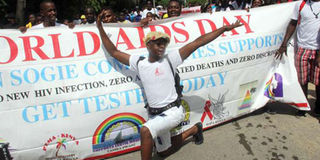Men reluctant to test for HIV - report

Residents mark World Aids day in Mombasa on December 1, 2015. Men account for only 30 per cent of people who have tested for the virus. PHOTO | LABAN WALLOGA | NATION MEDIA GROUP
What you need to know:
- According to a report by World Health Organization, men are to blame for slowing down the fight against HIV.
- In Nyandarua County, HIV prevalence level has slightly dropped, but new infections among youths are on the increase.
The World Aids Day was Thursday marked across the country with a report indicating that a majority of men still fear taking HIV test.
According to a report by World Health Organization, men are to blame for slowing down the fight against HIV.
Global coverage rates for all HIV testing, prevention and treatment are lower among men than women due to their perceptions that health services are not friendly.
Men account for only 30 per cent of people who have tested for the virus.
As a result, men with HIV are less likely to be diagnosed and put on antiretroviral treatment, according to WHO.
Consequently, in many settings, males have a higher HIV-mortality rate than their female peers.
The organisation revealed that nearly 70 per cent of all the adult HIV tests reported in 76 low and middle-income countries in 2014 were conducted in women.
“This is because HIV testing has been successfully integrated into reproductive health services, including antenatal care, but not consistently into other relevant clinic settings where men frequently visit,” said Dr Gottfried Hirnschall of WHO.
The research titled Supplement Guidelines on HIV Testing Services, released Thursday, revealed that as of June 2014, only half of 58 low and middle-income countries surveyed had policies supporting couples HIV testing services.
“Fewer countries still reported couples HIV testing Services rates over 20 per cent in antenatal care settings, with the offer of partner testing being even less likely outside of these settings,” he said.
First Lady Margaret Kenyatta, who led the national celebrations at Nyayo Stadium, Nairobi, said there was need for innovative messages that will specifically target the population to prevent infections and encourage those with the virus to adhere to ARVs and practice healthy choices.
Nearly 1.6 million Kenyans are HIV positive and according to 2015 statistics, with about 30, 000 new infections happening among adolescents.
In Nyandarua County, HIV prevalence level has slightly dropped, but new infections among youth are on the increase.
According to Regional HIV Coordinator Gladys Sang about 12,000 people are living with HIV in the county — 10 per cent of them are aged between 15 and 25 years.
Ms Sang said the county prevalence had dropped by 0.1 per cent from 3.8 per cent.
Annually, she said 275 adults and 14 children die from Aids-related diseases.
Ms Sang, who also oversees Laikipia and Samburu counties, was speaking at Wakiriogo Stadium in Miiharati town Kipipiri sub-county on Thursday.
More than 200 teenagers in Maralal, Sambururu underwent free voluntary male circumcision on Thursday as part of activities to mark the day.
By Eunice Kilonzo, David Macharia, Godfrey Oundoh and Angela Oketch




